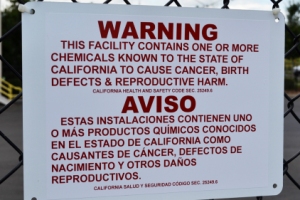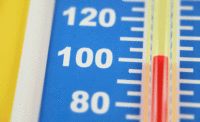WARNING. THIS AREA CONTAINS CHEMICALS KNOWN TO THE STATE OF CALIFORNIA TO CAUSE CANCER AND BIRTH DEFECTS OR OTHER REPRODUCTIVE HARM.
REPRODUCTIVE HARM.
The big message for manufacturers? Labels mitigate risk. But where do you buy the labels?
Can you print them yourself? How much do labels cost? Are signs more appropriate than labels?
Read on for a better perspective on product labeling for California Proposition 65.
These cautionary messages have become commonplace and can be found on an ever-growing list of buildings, stores and banks, too.
“Labeling will never go away,” said Greg Gyorda, Watts Water Technologies. “Our labeling program is well established, well underway.” Watts is a leader in the manufacture of products to control the efficiency, safety and quality of water within residential, commercial and institutional applications.
Attorneys offer further suggestions.
“Companies want to comply, but do not want the signage to interfere too much with the sale of a product,” said attorney Joseph Maternowski, Moss & Barnett. “I have seen a mix of clients ordering labels from outside parties to companies making their own labels. I have mostly seen labels printed on plastic and affixed to different surfaces. As far as quantities, a very large number are printed each year because the scope of Proposition 65 is so broad -- so many chemicals are covered and so many products are offered for sale.”
We know that warnings must be plainly visible. The size of the warning and the size of the label and package area depend on a number of factors. The law doesn’t specify size, font color or font type.
“Proposition 65 requires that warnings are ‘clear’ and ‘reasonable.’ Because the guidelines in the regulations are not specific about the details for signage, we work to help companies design signs that are likely to be seen by consumers to reduce the risk of Prop 65 litigation,” said Melissa Jones, Greenberg Traurig LLP.
So if you are responsible for your company’s product or service labeling and are wondering about how to make your labeling process smooth, efficient, fast and cost-effective, then here are a few considerations.
Do you purchase pre-printed labels or do you prefer to custom design and print them yourself?
How many labels, signs and/or packages do you print per year?
What types of surfaces must the labels or signs adhere to?
What are the dimensions of your labels?
How can color signs and labels complement your product design?
How quickly do you need your labels printed?
Do you need your printer to be mobile or stationery?
Will the label be exposed to extreme heat or cold? So an ice cream container, for example, might require a different type of labeling material than say a bag of potato chips.
Will the label be placed on a product that will be quickly used or has a long shelf life?
Would you benefit from the ability to generate safety signs and labels in addition to product warning labels?
These are just a few of the questions to address in your label design and printing process. Developments in vinyl printing supplies, many of which may be purchased online, will give you greater control of your process. Printers, too, have evolved over the years. They’re fast, quiet, easy-to-use and maintain and accommodate both continuous and die-cut labels.
Visit www.DuraLabel.comand www.labelers.us/prop-65.html for comprehensive product information and industry news.






